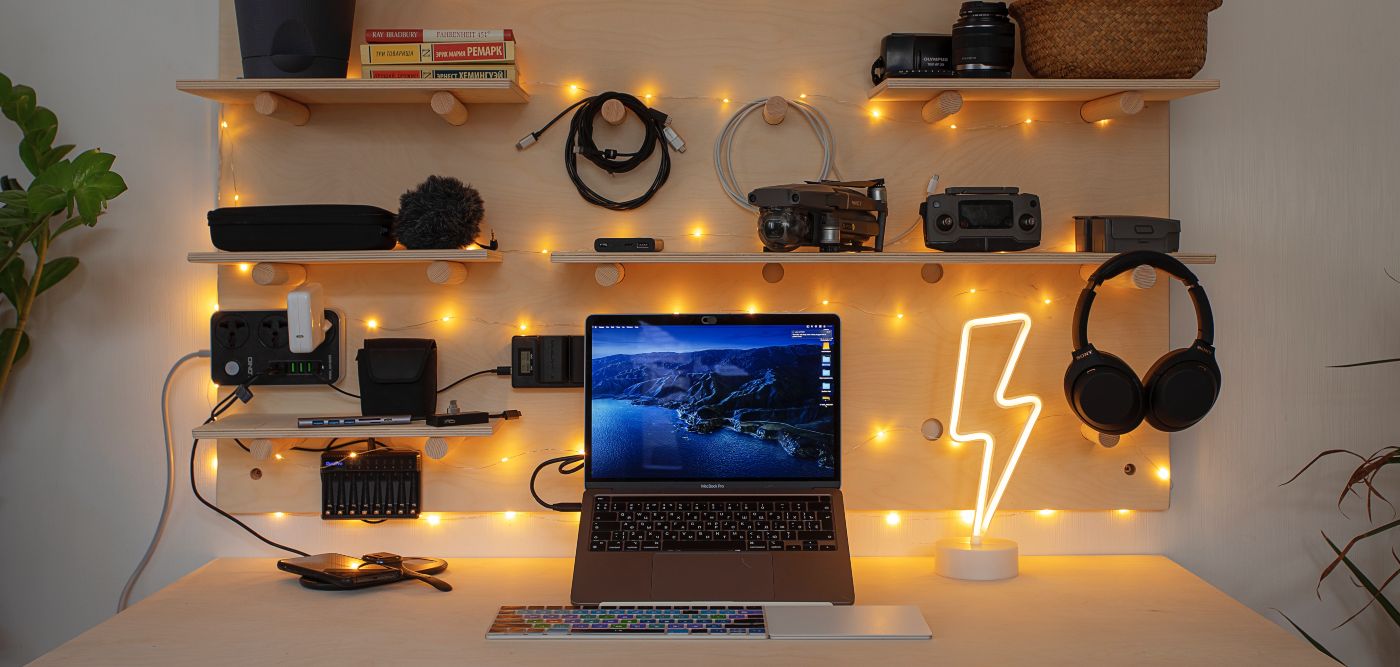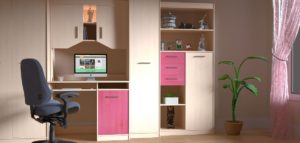Have you ever wondered what a desk hutch is? or if a desk hutch is something that could be useful for you? With plenty of people still, at least partially, working from home these days, the desk has become an enormously important piece of equipment. But that means we’re storing more and more stuff around it, and that can lead to clutter.
A desk hutch is a type of storage space found on top of the tabletop surface that you work on. A desk with a hutch provides a combination of drawers, shelves, and cabinets above the desk surface for extra storage space. You can find other hutches in dining room and kitchen furniture.
What Is A Desk Hutch?


As explained here, a desk hutch is a piece of furniture that sits on top of the desk, and it usually provides you with several shelves, and sometimes drawers or a cupboard that you can lock. Desk hutches can be small, offering just a couple of drawers or an extra shelf. Or they can be bigger than the desk itself and provide a lot of space.
The taller the hutch is, the more space you’ll have for organizing everything you keep on the desk, so more and more people are starting to add desk hutches to their home offices to make the most of the space there. If you’ve got a lot of equipment, they are a great addition to have, and they make the most of empty wall space.
Personally, I don’t mind a messy desk (hence the name of this site being Productive Mess). However, lots of people find that storage solutions, like a hutch, keep them more on track with their work. A hutch can mitigate distractions from things you’ve left lying around on the desk.
They look good because they give the desk more presence in the room, and help you to tidy it up. You can tuck all your supplies and work out of the way, but keep them close enough to easily grab when you’re mid-flow. The hours I’ve spent hunting for equipment seem pretty silly now I’ve got a desk hutch to work with.
Because they utilize vertical space, desk hutches are ideal for small homes, where you might not have the option of dedicating more floor space to your work. You can massively increase your storage options without losing any more floor footprint than has already been given over to the desk. There are multiple types of desk hutches, we’ll look at each one in more detail later on.
What Is A Computer Desk With A Hutch?

Not many computer desks come with hutches, but even here, some designers are starting to tap into the unused vertical space that sits behind the computer. Usually, the designs are simpler and don’t offer as much height, but they can still be advantageous.
A computer desk with a hutch will generally have an additional shelf or two. These generally sit above the height of a monitor, meaning that you can still push the monitor to the back of the desk (if you choose to). This makes it easier to achieve an ergonomic position where the top of your monitor is at eye height as recommended.
Some computer desk hutches do have shelves that are designed to sit behind the monitor, but this is a less common design because it is potentially less practical. In general, having shelves that are higher allows for easier access, a better aesthetic, and more flexibility.
What Is A Desk With Shelves Called?

Most people refer to a desk with shelves as a desk with a hutch. Of course, desk hutches may also take the form of cabinets or drawers, but shelves are the commonest storage option, sometimes combined with one of the other two. When we revamped our home office, we came across the term desk hutch and started using it.
This is usually the simplest way to refer to a desk with shelves, although some people may be unfamiliar with the term. A lot of people will simply say a desk with shelves, because “hutch” isn’t the most obvious phrase for the bit of furniture that sits above the level of the desk.
Types Of Desk Hutch
There are several kinds of desk hutches, and if you’re thinking of changing your desk to improve your storage space, it’s worth knowing more about them so you can select the right one for your office and needs. You could choose from an add-on hutch, a built-in hutch, or a wall-mounted hutch. Let’s explore these in more detail.
Add-On Hutch


If you already love your desk, this might be the best option for you, especially if you can find a hutch that matches it well. An add-on (as the name suggests) is just the top part of the desk – the shelves, cupboards, drawers, etc. This is attached to or rested upon your existing desk.
You can buy all kinds of add-on hutches online, but if you’re into DIY, you might be better off making one for yourself, or paying someone to make one for you. This means you can match your existing desk’s color and style, but more importantly, you can design it however you like.
If you know you need drawers and cupboards would be a waste of space, that’s fine – and similarly, if you’d rather just have shelves, you can create those too. You can find more about the size of desk hutches here.
I’m not saying you have to go through this much effort. Plenty of desk hutches are available on Amazon. But take this amazing hutch for a computer desk as an example of what you could do yourself if you are interested.
Built-In Hutch

A built-in hutch is a hutch that came with the desk when you purchased it, and is part of the same piece of furniture. With some desks, you may be able to detach it, but with others, it’s a fixed part of the furniture.
A built-in hutch is often taller than an add-on, because being built into the desk makes it more stable. However, if it’s very tall, the desk will need to stand against a wall to make sure it doesn’t topple over.
Built-in hutches often look better because they have been designed alongside the original desk. However, you don’t get to pick the height or layout.
Wall-Mounted Hutch


A wall-mounted hutch is more like shelves that you attach to the desk above the wall. They may also be attached to the desk, or they may just form part of the same workspace.
In the image on the left above, you can see an example of a floating desk with a hutch. This type of desk looks great and saves loads of space, although a floating desk can’t hold as much weight as a standard desk.
The advantage of a wall-mounted hutch is that you can use as much vertical space as you like without any risk of the desk overbalancing. The downside is that you can’t move the desk later. If you want a more custom setup, a DIY desk hutch is always an option. You can see an example of a DIY wall-mounted desk hutch setup in the video below.
What Is The Purpose Of A Desk Hutch?
A desk hutch is simply an additional storage solution, and you can put anything you want in your desk’s hutch. Many people store things like pens, pencils, erasers, staplers, etc., in drawers or a tray on the shelves. A pen pot may help to keep things organized if you don’t have drawers.
You can also put books, files, graph paper, notebooks, printing paper, and even a printer on the shelves. Work files, potted plants, and a lamp are other common additions, but you can really store anything you need on the shelves, or in the cupboards and drawers. You might want a spare phone charger and a few comfort items too.
If you’re anything like me, though, you should keep it strictly work-related if you want to stay focused!
If you want inspiration for your desk hutch ideas, here’s my Pinterest board for you. It contains a variety of desk hutches for direct inspiration and some other furniture hutches to spark some interesting ideas.







